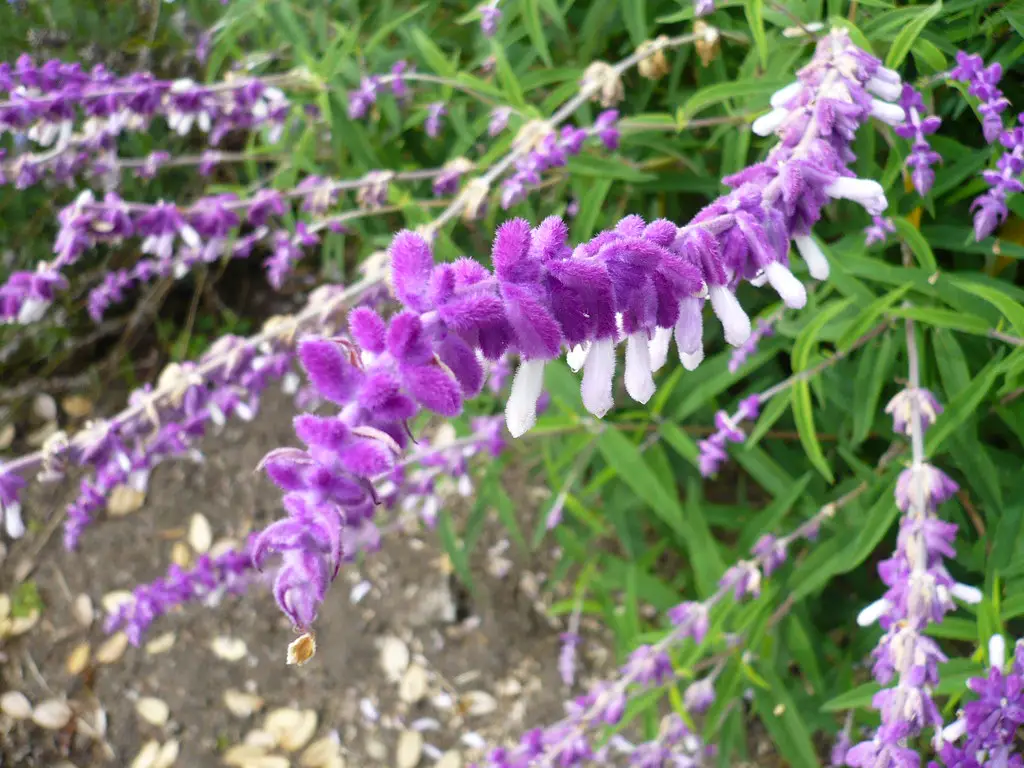Mexican Bush Sage (Salvia leucantha) is a striking perennial herb that thrives in the landscape with its beautiful, velvety purple or white flower spikes. With its colorful flowers, which are often accompanied by a soft and furry appearance, it adds texture and elegance to any garden setting.
Native to Mexico and Central America, this ornamental plant is well-loved by gardeners, not only for its visual appeal but also for its hardiness. It can endure heat and drought, making it a favorite in water-conscious gardens. Additionally, its nectar-rich flowers are known to attract butterflies, hummingbirds, and other pollinators.
As beautiful as it is functional, the Mexican Bush Sage is relatively low-maintenance and adaptable to various garden conditions. This makes it suitable for gardeners of different skill levels, from seasoned experts to novice enthusiasts. Here’s an in-depth look at this wonderful plant and everything you need to know to grow and maintain it successfully.
| Attribute | Details |
|---|---|
| Common Names | Mexican Bush Sage, Velvet Sage |
| Botanical Name | Salvia leucantha |
| Family | Lamiaceae |
| Plant Type | Perennial herb |
| Mature Size | 3-4 feet tall, 3 feet wide |
| Sun Exposure | Full sun to partial shade |
| Soil Type | Well-drained, sandy soil |
| Hardiness Zones | 8-10 |
| Native Area | Mexico, Central America |
Mexican Bush Sage Care
Mexican Bush Sage is recognized for its undemanding care requirements. Thriving in full sun to partial shade, it’s particularly renowned for its drought tolerance. Once established, it requires minimal watering and can even withstand periods of drought.
Planting Mexican Bush Sage in well-drained soil and a suitable location ensures its growth and flowering. While it’s adaptable to different soil types, sandy soil enhances its growth. Regular pruning helps in maintaining its shape, and occasional fertilization supports blooming.
Light Requirement for Mexican Bush Sage
Mexican Bush Sage grows best in full sun but can tolerate partial shade. A minimum of 6 hours of direct sunlight daily is recommended to encourage robust growth and abundant flowering.
Soil Requirements for Mexican Bush Sage
While adaptable to different soil types, well-drained sandy soil is ideal for Mexican Bush Sage. It prefers slightly acidic to neutral soil with a pH ranging from 6.0 to 7.0.
Water Requirements for Mexican Bush Sage
Though drought-tolerant, regular watering is essential during the first year of growth. Once established, it can endure longer periods without water. Overwatering should be avoided to prevent root rot.
Temperature and Humidity
Mexican Bush Sage can handle hot temperatures but is frost-sensitive. In colder regions, it’s better grown as an annual or protected during winter. Humidity doesn’t pose a significant concern for this plant.
Fertilizer
Applying a balanced, slow-release fertilizer in the early spring can enhance growth and flowering. Over-fertilizing should be avoided, as it may lead to leggy growth and fewer flowers.
Pruning Mexican Bush Sage
Pruning, especially after the flowering season, encourages bushier growth and more flowers. Cutting back the plant by one-third in early spring is recommended.
Propagating Mexican Bush Sage
Propagation can be done through softwood cuttings or division. Spring or early summer is the ideal time for taking cuttings or dividing the plant.
How To Grow Mexican Bush Sage From Seed
Growing Mexican Bush Sage from seed is possible but requires patience. Seeds should be sown indoors 6-8 weeks before the last frost date and transplanted after the risk of frost has passed.
Common Pests & Plant Diseases
Aphids
Aphids can be controlled with insecticidal soap or neem oil.
Powdery Mildew
Provide proper air circulation and avoid overhead watering to prevent this fungal disease.
Common Problems With Mexican Bush Sage
Legginess
This can result from inadequate sunlight or over-fertilization.
Flowering Failure
Lack of flowering may be due to insufficient sunlight or overly rich soil.
Pro Tips
- Consider planting Mexican Bush Sage near paths or seating areas to enjoy its unique texture and color up close.
- Pair it with plants that contrast its color and form for a stunning garden display.
- Deadhead spent flowers to encourage continuous blooming throughout the season.
- Mulching around the base of the plant helps retain moisture and suppress weeds.
- Plant in mass for a dramatic impact, especially in xeriscape or drought-tolerant gardens.




